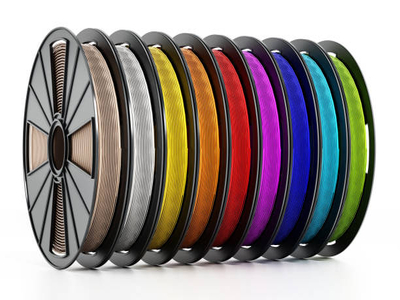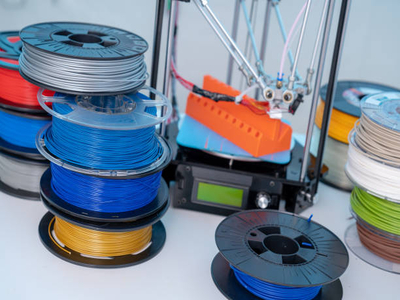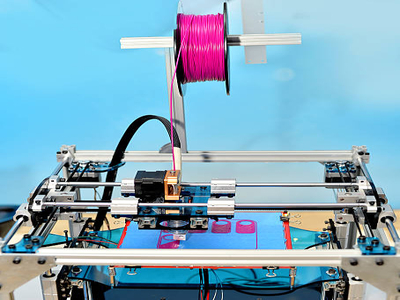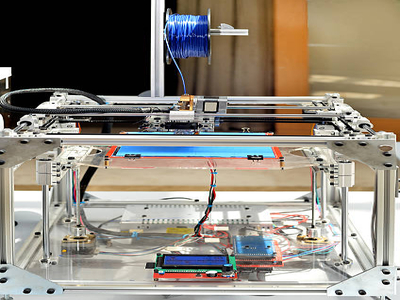How long does 3D printer filament last?
You can expect filament to last between 50 and 100 hours of printing time. This range depends on a number of factors such as print speed, the object being printed, and more.
This quick guide will cover how long 3D printer filaments last in detail, and give you some tips on how to make your filament last longer.
Types of Filaments and Their Different Lifespans

Different types of filaments have different lifespans, both in terms of how many objects you can print as well as conditional lifespan.
For example, ABS filament generally lasts longer than PLA filament, but how long your filament lasts also depends on how you use it.
An expert from Makerbot 3D printing compares ABS and PLA filaments so you can see the differences in the video below:
If you use your printer frequently, your filament will likely not last as long as someone who only uses their printer occasionally.
There are a few things that you can do to help make your filament have a longer shelf life:
- Avoid leaving your filament exposed to sunlight or other heat sources for extended periods.
- Store your filament in an airtight container when you’re not using it to prevent it from absorbing moisture from the air.
- Clean your print bed regularly to help prevent jams and other issues that can shorten the lifespan of your filament.
How Long Does PLA Filament Last?
PLA is one of the most popular filaments to use with various types of FDM 3D printers.
PLA filament typically lasts around 50-100 hours of printing or around 2 weeks of continuous printing.
However, this will vary depending on the earlier factors, such as the size and type of object being printed.
Read our related article, How Long Can You Leave a 3D Printer Running? Can you leave it running overnight? Learn more!
Advantages
It’s not only a biodegradable plastic made from renewable resources like corn starch and available in a wide range of colors, but it’s also easy to print with.
PLA filament also doesn’t require a heated bed to print, and therefore is ideal for lower-end printers that don’t have a heated bed.
Another benefit of using PLA, is that it has a relatively low melting point and can be printed at lower temperatures than other materials, reducing the risk of warping and making the printing process simpler.
Read our related article on the Best PLA Brand. We put different PLA filaments to the test and here are the brands that exceeded our expectations!
Disadvantages
Because of this relatively low melting point, PLA prints are not as strong or as durable as prints made with other materials such as ABS.
Another disadvantage of using PLA filament is that it is sensitive to moisture and can warp if it gets too hot.
How Long Does ABS Filament Last?

ABS, a petroleum-based plastic, is another popular filament material used in FDM printers.
ABS filament, similar to PLA, typically lasts for about 70-100 hours of printing, or around 2 weeks of continuous printing.
However, as with other filaments, this will vary depending on the earlier factors, such as the size and type of object being printed.
Advantages
This filament type is stronger and more durable than PLA and can be printed at higher temperatures, making it ideal for use with printers that have a heated bed.
ABS is also less likely to warp than PLA.
Disadvantages
On the downside, ABS filament is more challenging to print with, and produces fumes that can be harmful if inhaled.
Read our related article on the Best ABS Filament options. We tried the top filaments so you can make an informed decision for your prints!
How Long Does PETG Filament Last?
PETG, available in a wide range of colors, is a newer filament material becoming increasingly popular among FDM printers.
PETG, similar to other filaments, typically lasts for about 60-100 hours of printing, or around 2 weeks of continuous printing.
However, this will vary depending on the earlier factors.
Advantages
PETG filament is a solid and durable plastic that’s easy to print with and doesn’t produce harmful fumes when heated.
Disadvantages
One of the main disadvantages of PETG is that it can be challenging to remove supports, causing your prints to not be as smooth as you would like them to be.
Read our related article on the Best PETG Filament options. Here are our recommended PETG filaments and why we like them!
How Many Things Can I Print with a 1KG Spool of Filament?
How long does 3D printer filament last when it’s an average 1KG spool?
Here’s a short list of the variables the answer depends on:
- The type of object being printed
- The size of the thing being printed
- The infill percentage
- The layer height for 3d printing
- Print speed
Type of Object Being Printed
Some objects will use more filament than others due to the complexity of the model.
Printing large objects with many curves require more filament than a small, simple object as there is more surface area to cover, hence more material must be laid to create those curves.
Size of Object Being Printed

As you would expect, the size of the printed object will also affect how long your filament lasts.
The larger the object, the more filament that will be used. This is why it’s essential to consider the size of an object before you print it.
If you want to save on filament, the simple answer is to print smaller things.
Infill Percentage
The infill percentage is the amount of material used to fill the inside of an object.
A higher infill percentage means more material is used so the filament won’t last as long.
If you’re printing something that doesn’t need to be very strong, you can save on filament by using a lower infill percentage.
Layer Height
The layer height is the thickness of each layer that is printed.
A lower layer height means that each layer is thinner and requires more layers to print the same object, ultimately using more filament quicker.
If you want to save on filament, use a higher layer height. However, this will make the object less detailed.
Read our related article on Tough PLA vs PLA. See which is best!
Print Speed

Print speed, or the speed at which the printer moves while printing, also plays a critical role in how long your filament lasts.
While a higher print speed means the printer will finish printing quicker, higher speeds also mean using more filament.
If you want to save on filament, while it will take longer for your print to finish, use a slower print speed.
In the end, all these factors affect how long your filament lasts, but it’s important to consider all of them before you start printing.
By understanding how each variable affects the amount of filament used, you can optimize your prints to use less material and save money in the long run.
Conclusion
How long does 3D printer filament last?
The answer to this question honestly depends on the type of filament you use, how well you take care of your spools, how often you print, and the types of objects you print.
However, if we had to give a ballpark number, we’d say that most people can get away with using a single spool for around 2 months without any issues.
Of course, your mileage may vary. Some might have to replace their filament much sooner than that while others make one spool last them 6 months!
READ MORE